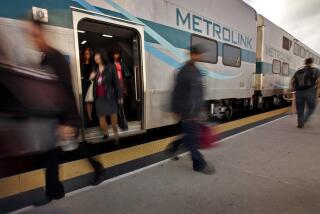Off on the Right Track? : Metrolink Marks 1st Birthday Amid Cautious Praise, and Some Concern
- Share via
Watching the San Fernando Valley slip silently by, Susan Wolf-Cohen wondered how she managed all those uncivilized years before the trains came--how she braved white-knuckle traffic to get to work tired and grouchy.
“This is the best thing they’ve ever done,” the Sherman Oaks legal secretary said as she traveled to Downtown Los Angeles on Tuesday, the first anniversary of the Metrolink commuter train service. Her stockinged feet were stretched onto the next seat and the morning paper was draped across her lap. “It changes your whole attitude.”
One year after they chugged onto the California commuting scene, the white and periwinkle Metrolink trains are whisking more than 8,100 people to work each day--four times the number they carried the first day.
They almost always arrive on schedule, officials boast, and have cut passengers’ travel times by a quarter.
There are now 48 daily trains and 196 miles of track in Los Angeles, Ventura, Riverside and San Bernardino counties. In December, a line connecting Downtown to Orange County will open nine stations, bringing the total to 30.
“The last year has been one where we have accomplished everything we wanted to do,” Metrolink Executive Director Richard Stanger said.
Despite the encouraging numbers, some experts wonder whether the trains will ever truly catch on in a region where private autos are as sacred as mom and apple pie. Even some supporters are cautious in their praise.
“I’d call it probably a moderate to a limited success,” said Los Angeles County Supervisor Ed Edelman, vice chairman of the Metropolitan Transportation Authority. “We have to examine whether we can make it better.”
On the trains Tuesday morning, regular commuters generally praised the service. They did, however, complain that there are too few work tables and that sometimes the trains run late.
Metrolink officials say they are upgrading some cars and concentrating on track and switching improvements to make lines run more smoothly.
But critics say there are deeper problems, citing nine train-related deaths and ridership figures that leveled off after an early burst. Ultimately, they question whether the trains--and the half-billion dollars in public investment they represent--will make any difference over the long haul.
Metrolink’s estimated operating cost for the current fiscal year is $43 million. Of that, only about 18% comes from passenger fares, which average about $7.20. The rest--about $12 per passenger trip--is subsidized.
Metrolink officials hope that growing ridership will increase the percentage that passengers pay over the next two years to 40%. In the meantime, some critics argue that subsidizing the trains’ mostly professional, mostly white, mostly suburban riders makes little sense.
“From my personal perspective, it is the bus service that we need to expand and rehabilitate,” Giuliano said. “People on Metrolink could car pool or drive tomorrow. They have alternatives. People I see on buses in South-Central Los Angeles don’t have alternatives.”
Anthony Downs, a senior fellow at the Brookings Institution, said he doubts whether the system, mostly used by people who work Downtown, will ever have much effect on rush-hour traffic. He explained that as more jobs are dispersed throughout the suburbs, concentrating transit improvements Downtown makes less and less sense.
Indeed, Steve Leung, chief of Caltrans’ traffic management branch, said Metrolink has had no noticeable effect on the Southern California freeway system. “Nonetheless, we definitely encourage people to use Metrolink,” he said.
*
Over the last year, nine people--including a teen-age couple--have died in Metrolink-related accidents, prompting some to question the system’s safety. Yet all but one of the fatal accidents involved pedestrians who were illegally walking on or near the rails.
In recent months, Metrolink has sponsored education programs to teach schoolchildren--the train’s future commuters--about rail safety.
In addition, sheriff’s deputies and local police are stepping up enforcement of trespassing laws and fences were built along a particularly deadly stretch of rail in the northeast San Fernando Valley.
More to Read
Sign up for Essential California
The most important California stories and recommendations in your inbox every morning.
You may occasionally receive promotional content from the Los Angeles Times.










